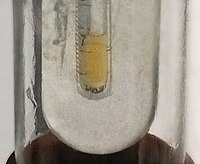
Photo from wikipedia
This paper presents a research overview, reconciling key and useful case study findings, towards uncovering major causes of gold refractoriness and maximising extraction performance of specific gold flotation and bio-oxidation… Click to show full abstract
This paper presents a research overview, reconciling key and useful case study findings, towards uncovering major causes of gold refractoriness and maximising extraction performance of specific gold flotation and bio-oxidation products. Through systematic investigation of the ore mineralogical and gold deportment properties, leaching mechanisms, and kinetic behaviour and pulp rheology, it was observed that the predominant cause of the poor extraction efficacy of one bio-oxidised product is the presence of recalcitrant sulphate minerals (e.g., jarosite and gypsum) produced during the oxidation process. This was followed by carbonaceous matter and other gangue minerals such as muscovite, quartz, and rutile. The underpining leaching mechanism and kinetics coupled with the pulp rheology were influenced by the feed mineralogy/chemistry, time, agitation/shear rate, interfacial chemistry, pH modifier type, and mechano-chemical activation. For instance, surface exposure of otherwise unavailable gold particles by mechano-chemical activation enhanced the gold leaching rate and yield. This work reflect the remarkable impact of subtle deposit feature changes on extraction performance.
Journal Title: Minerals
Year Published: 2021
Link to full text (if available)
Share on Social Media: Sign Up to like & get
recommendations!